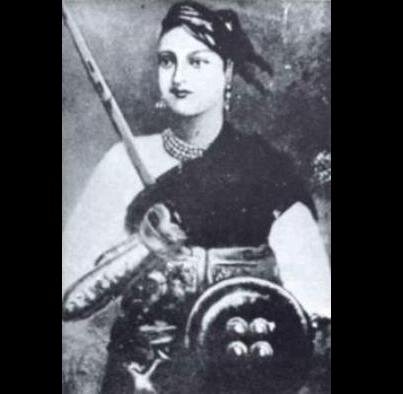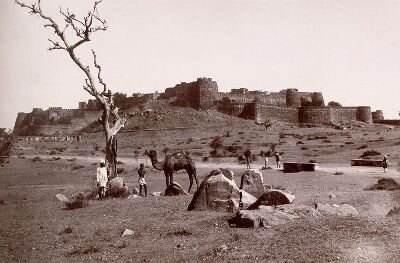Rani Lakshmibai
"Thus the Maratha Queen tall in statue, handsome in person, young, energetic, proud and unyielding from that moment indulged in the stern passion of anger and revenge."
People generally like to refer to the warrior-queen Rani Lakshmibai as India's version of Joan of Arc. And yes, sure there are plenty of obvious similarities between this young warrior-maiden who came out of nowhere to lead her people in their efforts to skewer Englishmen through the torso with a bunch of keenly-sharpened metallic objects, and the fact that she's considered a martyr for the cause and revered by her countrymen even to this day bears quite a resemblance to the nut-squashing antics of the Limey-cleaving Maid of Pucelle. Personally, however, I think I would argue that she's more akin to being the William Wallace of India rather than anything else – not only because this insane never-say-die blood factory was tall, charismatic, and more then capable of personally sawing your brain in half with a giant two-handed sword, but because she was also incredibly successful in leading her overly-oppressed comrades in a valiant, brutal rebellion against British occupation of their homeland.
Born in 1835 in the Princely state of Jhansi in Northern India, Rani Lakshmibai's mother died when she was just a young child, leaving most of the child-rearing duties to her incredibly-busy father, the King of Jhansi. As a member of India's elite warrior caste, Dad knew the value of being able to lop peoples' helmets off with one swing of a blade, so he decided to forgo the bullshit curriculum usually foisted upon Indian women at this time and instead opted to teach her how to do badass shit like ride elephants, jump over fire-pits on horseback, swordfight, shoot a crossbow, load a musket, read, and write. Training in the arts of war every waking moment, Lakshmibai quickly became an unstoppable snowplow of sare-wearing destruction, and even passed on the secret art of scrotal-annihilation to any other women of the court who thought it would be totally flippin' sweet to kick peoples' asses. Before long, Raini managed to assemble an ultra-loyal personal bodyguard of mecha-tough women courtiers who doubled as organic wood chippers capable of slicing and dicing people apart like a paper shredder tearing through a necktie.
MEGA XTREEEEEEEEME
As soon as she was old enough, Lakshmibai was married off to some older guy, as was the custom in the day. But the quiet, demure life wasn't in the cards for this hardcore chick. A few years into the marriage, she had a son, who died at four months old, and then almost immediately lost her husband just a year and a half later. In the wake of these these terrible tragedies, the new Queen of Jhansi adopted a son to serve as heir to the Kingdom as soon he was old enough to rule. In the meantime, she'd serve as his regent and bifurcate the craniums of anyone who wanted to fuck with him by suplexing a whirling circular saw on their heads.
The main big dogs in India during the mid-19th century was a power-hungry ultra-capitalist mega-corporation known as the British East India Company. If it helps, you can think of these guys as being like something out of Shadowrun, Blade Runner, or any of the other hundred-billion cyberpunk dystopian sci-fi futures where super-powerful evil companies spend all their spare time plotting world domination and developing diabolical schemes, only these guys were real, super powerful, and their private armies were equipped with tech that far outstripped anything that was possessed by the indigenous peoples they were currently dominating. Basically if you ruled a province in India in the 1850s, you had two options: do what these guys say, or be forcibly replaced by someone who will. And when the East India Company heard that the King of Jhansi was an adopted young boy with no royal blood, the high-ranking company officials declared the throne to be "lapsed", and the region to be "officially in the getting-fucked-by-us business." Rani was deposed, given a small pension, and told to keep her mouth shut and deal with it if she knew what was good for her.
But Rani Lakshmibai wasn't the sort of warrior-chick who wasn't going to sit around take a heaping handful of disrespect without replying with a bindi-ed headbutt of vengeance. First, she tried the go the legal-yet-less-violent bureaucratic route, filing a formal appeal in the British courts, and going to trial to assert the legitimate right of her and her adopted son to rule. This failed, of course, because the courts were being run by the people trying to screw her over. The British continued to diss her, overtax the populace, and – even worse – they began to systematically slaughter sacred cows and chop them up for food. It was more than obvious that negotiations weren't working, and the justice system was just as bullshit then as it is today.
Somewhat fortuitously, in June 1857 the entire Indian army mutinied against the forces of Colonial Britain, because honestly nobody in the country could really stand those guys. Seeing an opportunity arise at the perfect moment, the 22 year-old Queen Lakshmibai formally declared open revolt five days later, attacked the British fort at Jhansi, recaptured her homeland, and massacred every British man, woman, and child she could get her hand son (which was pretty much all of them.)
The fort at Jhansi, circa 1860 or so.
The walls were perfect for defense against warriors,
but were somewhat less effective versus cannons.
(I should mention that the sources aren't particularly clear about her involvement in the massacre – some people claim not only that she wasn't there, but that she was officially reinstated as Queen of Jhansi by the British after she came out and publicly decried the violent murder-fest as being bad and wrong and wrong and bad. I had a hard time figuring out where the truth was in this story, so feel free to go ahead and believe whichever version makes you feel better about yourself.)
Whatever the case may be, Rani Lakshmibai quickly solidified herself as ruler of Jhansi, built up her defenses, and a lot of British people were cleaved apart in the process. During the events of the Great Indian Rebellion of 1857, Lakshmibai consolidated her small kingdom, trained the men and women in her service in the arts of combat, and on two separate occasions personally repelled two large-scale invasions from jackass rival regional lords. Some reports indicate that she personally charged into battle on horseback on countless occasions with her child strapped onto her back, a sword in each hand, and the horse's reins in her teeth. That's fucking hardcore. I picture it being like a 19th-century cavalry version of Ripley incinerating the Alien Queen's egg baskets with a blowtorch duct-taped to a machine gun while carrying Newt around in her other arm.
Seeing that the loyalist forces were unsuccessful in taking down this hardcore chick and her heavily-entrenched, highly-disciplined army, the British general Sir Hugh Rose launched a full-scale invasion of his own, bringing a couple thousand men and cannons to blow Jhansi to shit until the people there had the good sense to surrender. Despite facing a crippling force that would have explodiated the fuck out of most other city-states in about ten seconds, Rani held out for two full weeks against the onslaught, clinging to survival just long enough for a 20,000-man strong relief column to arrive from a nearby rebel province and attack the flank of the British Army. She had succeeded in holding out to defend her city.
Uh, unfortunately for Rani, the rebels hadn't really had much experience with heavy artillery, and the first couple cannon shots blew the shit out of their ranks and they ran away. Fuck.
Having put all her eggs in the "massive horde coming to my aid" basket, and now seeing that the situation was now utterly hopeless, Rani evacuated as many people as she could in the middle of the night, abandoning the village and retreating to link up with another rebel group nearby. Combining her forces with that of the remaining mutineers, she continued to fight her way through what was increasingly becoming a hopeless effort to overthrow colonial rule in India. She led her warriors to defeat the Maharaja of Gwalior after he defected from the rebel cause, but was killed in battle during a counter-attack by the British 8th Hussars Regiment while trying to rally her troops. Fulfilling her dying wish not to let her body fall into British hands, her followers built a funeral pyre in the middle of the battlefield and burned her on the spot. The rebellion would end up being quashed by the British, and India would remain a colony until 1948. Her son survived the war, but spent his years living out on a British pension and renouncing his claim to the throne. As a result of her personal leadership, ferocity in combat, and hardcore tenacity, Sir Rose would later be quoted as saying that she was the bravest, most fearless, and most dangerous rebel commander of the entire Indian uprising.
Over the years, the Queen of Jhansi has become a near-mythical hero among the people of India for her role kicking ass during the 1857 Rebellion. She fought bravely, refused to surrender, and died the death of a martyr for freedom. She now has a couple statues in her honor, is included in all Indian history textbooks, met Flashman a couple times, and is so synonymous with being an asskicking chick that when the Indian National Army put together an all-female infantry unit during World War II they had the good sense to name it after her.
Links:
ILoveIndia.com
MapsofIndia.com Wikipedia
Sources:
Agrawal, Lion M. Freedom Fighters of India. Gyan, 2008.
Cook, Bernard A. Women and War. ABC-CLIO, 2006.
Gupta, Om. Encyclopaedia of India, Pakistan, and Bangladesh. Gyan, 2006.
Jain, Simmi. Encyclopaedia of Indian Women through the Ages. Gyan, 2003.




